Introduction (updates at foot of page)
November 2022: See our new page Background information on ghost signs.
This project revolves around
humanity's constant
need
to define and promote itself through signs. The publicly visible
lettering
on buildings and structures in a busy port, market and industrial town
like
Ipswich has been used for decades to communicate with the passer-by.
This
practice can probably be dated to the beginning of the Industrial
Revolution
in Britain (around 1750 – see our Timelines
page for common historical terms), when the
rise
of capitalism resulted in the need by industrialists and businessmen to
advertise, self-promote and proclaim commercial power. Large building
projects and structures such as tall chimneys and bridges provided the
canvass for this trade lettering.
The twenty-first century sees us facing more and more invasive ways of
advertising
brands and services, particularly given the impecunious nature of
public
services and their desire to obtain sponsorship from commerce in order
to
save money wherever possible*. This current climate of 'private/public
partnership'
is a world away from that prevailing a hundred or so years ago when
corporations,
tradespeople, factories, businesses and all sorts of private
individuals
marked their existence with the aid of signwriting and public
lettering.
[*Not that we would ever encounter that sort of problem with
advertisements
on the Internet...] For an insight into the genesis of
this website, see our Symonds
For Kodaks
page.
A photographic
comparison
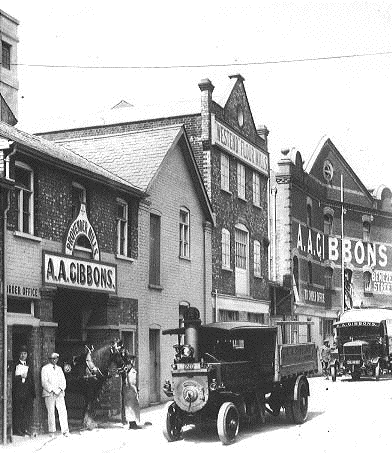
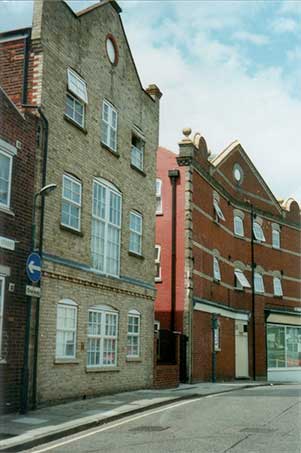 2001 image
2001 image
The photograph
(above) of the upper end of Benezet Street demonstrates
the
use of bolt-on and painted signs by a flourishing flour-milling
business,
Provender Mills and West End Mills owned by A.A. Gibbons. Alfred
Alexander
Gibbons set up his corn business in Benezet Street in the 1880s, the
monochrome
photograph having been taken in the 1920s. The far building with its
angled
Paladian frontage is adorned with three sets of painted lettering: the
owner's
name, the street name (close to the corner with Bramford Road) and the
smaller
'To Order Office' directing customers down the road. Although a fairly
narrow
street, the proprietor clearly saw the need to stamp his name clearly
on
the far building which would have been partially visible by those
passing
on Bramford Road. The colour photograph taken from a similar position
in
2001 (the nearest buldings have been reshaped or demolished) shows a
typical
modern approach to the utilisation of industrial buildings as
attractive
office and accomodation spaces. The brick-cleaning companies have been
in,
masonry paint applied, frontages repaired, windows and features altered
and all signs have
been
removed.
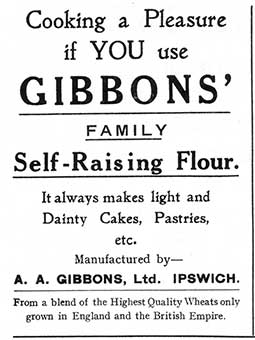 1934 advertisement
1934 advertisement
The above advertisement comes from "The Myrtle", the Ipswich (Museum Street) Methodist Church
Magazine, August 1934. Other advertisements
from this publication can be found on our Woottons hairdresser in Tavern Street and Scarborow opticians in Dial Lane. Thanks to
John Barbrook for the publication.
One of the finest expositions of the signwriter's art must surely have
been
that shown below: a veritable symphony of signs. Also, at right, a
mock-up of the bakery imposed onto a 21st century photograph of The
Purple Shop and the Fonnereau Road corner.
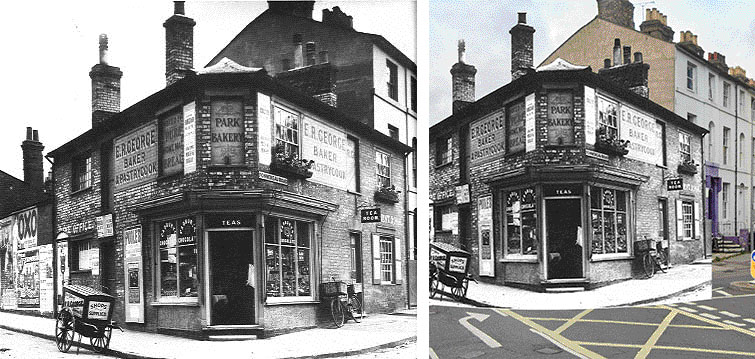
At the corner of Fonnereau Road and Crown Street
(demolished for road-widening), here is E.R. George's bakery in 1911.
Reading from the left:-
'BAKE OFFICE' (above the hand cart – see our images of Felaw
Street Bake Office for an
explanation of this term),
'E.R. GEORGE: BAKER & PASTRYCOOK' (caps with white drop shadow;
repeated on the Fonnereau Road elevation),
'NOTED FOR PURE WHOLE MEAL BREAD' (in a blind window),
'PARK BAKERY' (in a blind window, with curlicues above and below),
repeat of main sign,
unreadable lettering in bricked up window (probably the proprietor's
name
and trade repeated),
'REFRESHMENT ROOM' (behind the 'TEA ROOM' sign),
not to mention all the advertisements and posters including an OXO
sign, plus the lettering on the shop window glass and 'TEAS' above the
corner door.
The blank wall beside the premises has been colonised by bill-posters.
In
those somewhat gloomy times such colourful, graphic, printed matter
might
have ben welcome and it is only in recent decades that Ipswich Borough
Council
has taken a stance on the proliferation of billboards and advertisments
in public places. The environment now is radically different and once
the
billboards were removed from many sites in the 1980s (thanks, in part,
to the lobbying of The Ipswich Society), new views into formerly hidden
areas and
spaces
were revealed.
Another striking exercise in trade lettering adorned the angled side
wall of number 46 Norwich Road; this grand wall advertisement for W. Rush's fish game and
poultry shop was seen by people coming from the town. It is now the
Maharani Indian Restuarant
which still has an interior illustrated ceramic wall showing people and
dogs on a shoot, which was behind the original shop's game counter, the
sister mural – perhaps showing fishing? – having been demolished
by the builders during conversion to a
restaurant before it was spotted by a
conservation officer). but is long gone.
A collaborative resource
The main feature of this website is to attempt to
provide an
authoritative
commentary
and amass historical detail by a collaborative process. If some of the
text
is misleading or just plain wrong, we want to hear about it and correct
it, so that the site grows as a resource of historical public lettering
and the local history of Ipswich. We are particularly keen to hear from
residents who recall the streets, businesses and features depicted in
the
galleries; also the types of trades involved, anecdotes about the areas
and people of Ipswich.
Please email any comments and contributions by
clicking here.
Attribution
We aim to credit or provide attribution to images used
on the site which are not photographed by us. If you are able to help
us
with information about a source or copyright relating to a
particular image, please email us.
The technical side of lettering
We hope to research this more thoroughly with
commercial signwriters in
the future.
Suffice to say that the art and craft of signwriting is, perhaps, a
dying
one. The use of ladders, scaffold, mall-stick and signwriter's brushes
and
paints to create a sign on a wall is far more challenging than that
done
on a removable board which can be created in a workshop and fixed in
place
(the latter being intrinsically temporary). This is particulary true of
the more out of the way sites such as the chimney stack above the
former
Symonds Chemists Shop in Upper Brook Street.
One of the largest – and presumably most challenging to execute –
painted wall-signs can be seen in Hamilton Road, Felixstowe: the
spledid E.F. Andrews advertisement.
Today, more and more flashy effects can be achieved by the use of
plastics
and metals in sign-making, noy to mention laser projection: rather
different activities. The emphasis
throughout
this site is on painted lettering, principally on brickwork and
rendered
surfaces which tend to stand the test of time. There are also examples
of
lettering incised into the fabric of buildings such as at the top of
the
frontage of the Bethesda Church, St
Margarets
Street, or lettering built out in relief on a surface, for example The
Unicorn in Tacket Street or The
Central
Livery and Bait Stables in Princes Street.
There are therefore implications in this project for design and
architecture,
too. Not to mention the practical problems of painting onto a porous
surface
where the lettering is intended to last for years. The examples of
painted
signs for local businesses such as Elliott
Street Bakery - a remarkable survivor - show how a number of
versions
are overpainted as the years pass and fashions change; then weathering
and
degrading of the paint surface result in the earlier lettering becoming
visible. This is the very embodiment of social history in a very humble
and largely forgotten feature of the town.
Inclusions and exclusions
Although we have not adhered to strict rules about
inclusions and
exclusions,
the examples photographed must exhibit some age and durability since
their
original creation. The signs on Church's Restaurant in Hatton Court and
pubs
such as the Milestone (formerly the The Beer HouseMulberry Tree,
Mulberrys) in Woodbridge Road
and the County Hotel
in St Helens Street have all the appearance of period lettering, yet
have been painted only
recently. This false 'olde worlde' approach to public lettering has its
interest, but falls outside our brief.
The Duke of York on the corner of
Woodbridge Road and Warwick
Road brings to mind those lettering examples which
we have lost. That particular pub boasted some rather fine frosted
glass
decoration in its former incarnation. When
Adnams,
the Southwold brewers, refurbished the premises they removed the
wonderful
door to the left of the frontage which led to a corridor and short
'private'
part of the bar for off-sales; the door bore the frosted word: 'Jugs'.
However, they did commission some rather good engraved windows (noy
vinyl additions). Hales
Chemists in St Helens Street (opposite the Regent)
was in business for
many
years and was only closed down with the opening of a chemist's
shop
within the Orchard Street Health Centre nearby. The lost lettering
proclaiming
the business name in black and white mosaic on the entrance doorstep
was
only spotted by chance and was soon obliterated with dark grey paint by
the new owners: a bespoke tailors. The wear and tear
caused
by shoes and boots have continued the erosion already visible on the
step
and finally revealed the lettering once more.
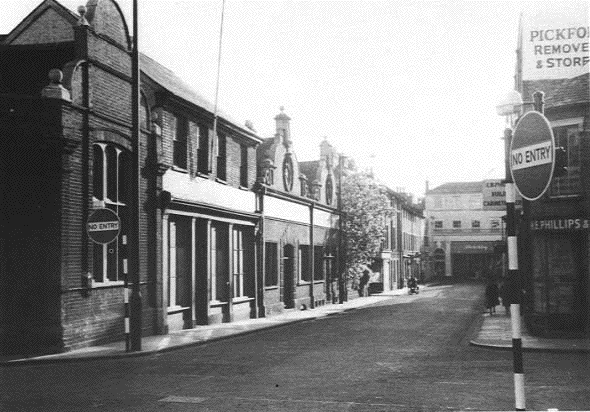
The above 1960s photograph of Great Colman Street from
the corner of
Old
Foundry Road by Jim Lewcock shows a rake of buildings on the left long
demolished
to make way for the Social Security block and Carr Precinct, since
superceded
by the QD development. At this time, the rather attractive frontage
housed
Rands & Jeckyl, the tent makers, and the small street about half
way
down, Little Colman Street (now an access to a ramp leading to upper
parking),
cut through to Carr Street. The facing building at the end of the road
(itself
in Northgate Street) has been an Assembly Rooms, the girls' public
school (which moved to Westerfield
Road, then to Wolverstone Hall), Egertons
motor engineering works , Sketchley dry cleaners (we think it's the
company name on the building's frontage above), Mortem's stationers and
The
Chicago
Rock Cafe (and other night clubs). The part of the photograph which
drew our attention, though,
is the end wall of the stores to the upper right. Until recently this
was
Websters office furnishers, stores and auction rooms and presumably
that
company was responsible for the obliteration with white paint of the
earlier
tenants: 'Pickfords Removers and Storers'. The great white panel, just
made
for advertising lettering, was still there until recently, albeit
somewhat
flaking
and discoloured. As of 2005, the Websters building has been demolished
for housing redevelopment.
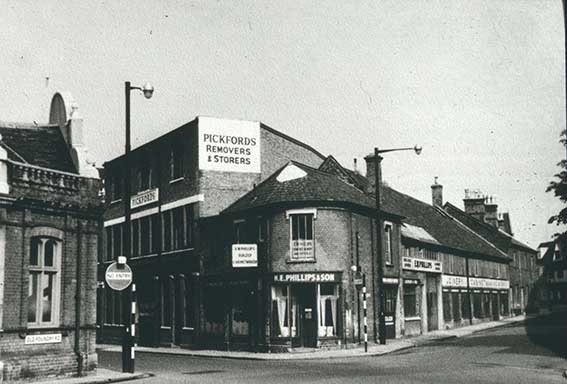 Photograph courtesy the Ipswich Society
Image Archive
Photograph courtesy the Ipswich Society
Image Archive
[UPDATE 18.12.2017: John Norman
passes on this alternative view of the junction showing the full
Pickfords sign. The original photograph was by Peter Underwood.]
All the time, we are in danger of losing these historic examples of
lettering.
Since starting this website in June 2003, we have lost John
Good and Sons (G.C.B.) Ltd on the Wet Dock, where the
Waterfront Regeneration Scheme
has removed several examples. Abrasive brick-cleaning, overpainting
with a textured masonry paint,
rendering
over with cement or rough-cast all threaten to obliterate our history.
It
is intriguing to contemplate what might eventually happen when such
sufaces
weather and crumble. If the buildings stand for long enough will they
once
more yield up their secrets, covered up and (one hopes) protected for
so
long? There are sites where the enthusiastic use of a red brick paint
to
cover lettering has followed the contours of the characters rather too
slavishly
and with the passage of time, only serve to make them readable again.
The
R. & W. Paul maltings at the rail
station
end of Princes Street (formerly Hollywood / Kartouche / Zest night
club etc.) is a
fine
example. Our These we have lost
page records the Ipswich lettering which is no more.
We have tended to shun signs and characters which are fixed to walls
and
favour those painted onto them. However, there are road
and street signs (which carry their own unique history as
illustrated on our Street name derivations
page) and other
exceptions
where they carry the weight of the past. We have a limited selection of
eccelesiastical
lettering as the many churches in the town have grave stones and
memorials,
as well as architectural lettering which are all strictly speaking
'public'
and which are a subject in themselves.
The original 'gif ' images on this site
sometimes lack definition so since 2005 we have replaced most with
'jpeg'
files. We
have tried to provide close-ups and enhanced images where it is useful
to the browser.
[UPDATE 25.10.04: Borin Van Loon gave a talk on this website
project
to the annual Recorders' Day in October, 2004 organised by Suffolk
Local
History Council which exists to encourage, promote and assist the study
and research of local history in the county of Suffolk. We hope for
much
feedback from this source, so that we can fill in many of the gaps on
the
site. They proved a receptive, knowledgeable and enthusiastic audience;
it was good to share some of the images and the thinking behind the
website
with them.]
[UPDATE 15.11.06: We have ditched the Guestbook from the Homepage
due
to endless spamming. Also citations to published
books in the text have been gathered together in a Reading
List.]
[UPDATE 17.9.09: A major change! The imminent demise of
our web host,
Geocities, has led us to sign up for a paid service and get ourselves a
domain name - http://ipswich-lettering.org/. This has led to an
overhaul of all pages and the bringing into the site the pages which
use to be on a separate Geocities site covering vestigial lettering and
examples from outside Ipswich. All links within the site are now being
checked and we can then start on the back-log of material we've
accumulated in the last year or so.]
[UPDATE 8.1.10: Addition of new pages with contributions from
enthusiasts (very gratifying), revision of old pages, constant checking
and remaking of links and more to come. Now that we don't have to worry
too much about shortage of memory at the server end, we're minded to
revisit some of the old, rather clunky gif images on the sight and
create better resolution ones to enhance lettering and context. Work
continues...]
[UPDATE 1.3.2012: A round-up
over the last two or three years. New features on this website are
being added to increase the ease of access. The Pubs & Off-licences
page draws together scattered examples from licensed premises. These We Have Lost documents notable
historic lettering examples which no longer exist in our town - we were
heartened to find that, contrary to our perception, there weren't too
many of these. We hope to make more themed pages in the future. We are
constantly adding to and expanding our Ipswich
Street Names page to show derivations of nomenclatures. The
introduction of our Street Index is
designed to give easy access to material when browsers know the
location of a particular piece of lettering. The replacement of old -
often rather nasty - 'gif' format images with more attractive digital
'jpegs' continues and improves the visual appeal of our pages.
Reluctantly, a few years ago we could resist no longer and introduced
pages for places in Suffolk outside Ipswich (such a big subject!), but
now we have pages from all over England and even France and Canada,
Contributions of information, reminiscences and images, corrections
etc. are always welcome: Contact us.]
[UPDATE April 2012: (one we
forgot to include last year). We are pleased and honoured that The
Ipswich Society Newsletter featured our website in a short
review in
the April 2011 issue.]
We have included a page of timelines
on the site to act as an aide-memoir
of periods in history and of English monarchs.
[UPDATE February
2013. This website features in a full page
article on Ipswich Ghost Signs (EADT 9
February
2013). Lots of images provided by us.]
[UPDATE
December
2013: A talk about this website by Borin
Van Loon: Wednesday 18 December 2013, 7.30pm: ‘Historic trade
signs in Ipswich’ to the Ipswich Society (see Links) at Museum Street Methodist Church
Ipswich.]
[UPDATE
24.12.2013: We are
pleased to include Paul Horne's research and images concerning Boundary markers in and around
Ipswich.]
[UPDATE
8 May 2014: A second
talk by Borin, this time to the Ipswich Arts Association (see Links) on 'Street letters', emphasis
on lettering from streets and
houses. Very nice to meet old and new friends of this website at these
events. Well-received by a
good-sized audience, despite the heavy rain.]
[UPDATE
13.9.2014: Borin
created a display of over thirty images from this website for the
Ipswich Maritime Trust (see Links) exhibition
in the Custom House on Heritage Open Weekend organised by the Ipswich
Society on 13-14 September 2014:]
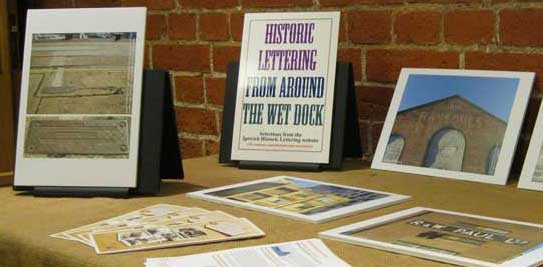

[UPDATE 25.10.2015:
After a brief period when we fell off the web, this website is now
hosted by BigWetFish in Ireland and we hope that we'll be available,
not to mention stable, for a long time to come. With the
inaccessibility of the Yahoo server (Wisconsin), we have lots of
updates from June onwards. As we work through these, check all images
and links (yes, hundreds of 'em) and add new pages, we feel that we're
getting back on track. Tell your friends: we're now at www.ipswich-lettering.co.uk.
[UPDATE January 2018:
over the past couple of years Borin has given several talks about this
website to a variety of groups. Meanwhile the site continues to grow
and develop in response to the kind interest and contributions from
web-browsers all over the world. Who'd have thought that a little
project on old, faded trade signs in Ipswich in June 2003 would have
become so extensive. Keep 'em coming.]
[UPDATE September 2018: Ipswich
Historic Lettering now has a site-specific search
engine (linked from the Homepage) which will help visitors – and us
– to find things on the website. Hurrah! The suggestion came from
Morvyn Finch, to whom our thanks.]
[UPDATE July 2019: At long
last, the six year old clutch of photographs taken during a single walk
around Norwich have their own page. This
county town has been missing from the Ipswich Historic Lettering
website for too long and we celebrate the remarkable variety of
lettering to be found there.
[UPDATE 23.9.2019: this website
was launched on the world, albeit in embryonic form, in June 2003 and
we have now learnt that an internet archive of our original Geocities
web-host includes an
early version of the Ipswich Historic Lettering website. At this
time we included only moderate quality .gif files for the photographs.
Jpeg files are now almost universal on the website.]
Look out for:
Rampart and Town gates;
House
name plaque examples: Alston Road;
Bramford Road;
Cauldwell Hall Road; Cavendish Street; Marlborough Road; Rosehill area;
Ipswich & Suffolk Freehold Land
Society (F.L.S.); California;
Street index; Origins of street names
in Ipswich; Streets named after slavery
abolitionists;
Dated buildings list; Dated buildings examples;
Named
buildings list;
Named (& sometimes dated) buildings
examples;
Street nameplate examples; Brickyards;
Ropewalks
in Ipswich
Monasteries
in Ipswich; Boundary
markers;
Historic maps of Ipswich
Water in Ipswich
Ipswich
Tomorrow, Greyfriars 1960s
Listed buildings in
Ipswich
Windmills
in the Borough of Ipswich
Home
Please email any comments and contributions by clicking here.
Search Ipswich
Historic Lettering
©2004 Copyright
throughout the Ipswich
Historic Lettering site: Borin Van Loon
No reproduction of text or images without express written permission

 2001 image
2001 image 1934 advertisement
1934 advertisement

 Photograph courtesy the Ipswich Society
Image Archive
Photograph courtesy the Ipswich Society
Image Archive
